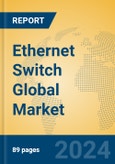Market Size and Growth Forecast
The global Ethernet Switch market is estimated to be valued between USD 43 billion and USD 45 billion in 2025, with a projected CAGR of 4% to 6% from 2025 to 2030, potentially reaching USD 23 billion to USD 27 billion by 2030, reflecting steady network demand.Regional Analysis
- North America: Growing at 3-5%, the U.S. leads with enterprise and data center use, trending toward high-performance switches.
- Europe: With a 3-4% growth rate, Germany excels in campus networks, focusing on sustainable designs.
- Asia Pacific: Exhibiting a 5-7% growth rate, China dominates with telecom and manufacturing scale, trending toward cost-effective solutions.
- Middle East and Africa (MEA): Growing at 2-4%, the UAE advances with carrier networks, emphasizing reliability.
- South America: With a 2-3% growth rate, Brazil leads with enterprise growth, focusing on affordability.
Application Analysis
- Enterprise & Campus: Projected at 4-6%, it thrives on business connectivity, trending toward scalable, secure switches.
- Carrier Ethernet: Expected at 3-5%, it serves telecom needs, with high-reliability designs rising.
- Data Center: Growing at 5-7%, it drives high-speed demand, shifting to high-port-density solutions.
Product Type Analysis
- Modular Switches: Projected at 4-6%, they excel in flexibility, trending toward customizable deployments.
- Fixed-configuration Switches: Expected at 3-5%, they serve cost-effective needs, with compact designs rising.
Key Market Players
- Cisco Systems: A global titan in robust networking solutions.
- Huawei: A versatile innovator in scalable switches.
- Arista Networks: A dynamic leader in high-performance designs.
- HPE: A reliable provider of enterprise-grade systems.
- H3C: A spirited creator of cost-effective solutions.
- Juniper Networks: A strategic pioneer in secure networking.
- Broadcom: A precision innovator in switch technologies.
- D-link: A practical provider of accessible switches.
- Allied Telesis: A resourceful leader in reliable designs.
- Alcatel-Lucent Enterprise: A vibrant innovator in campus solutions.
Porter’s Five Forces Analysis
- Threat of New Entrants: Medium, with technical and brand barriers, though niche players emerge.
- Threat of Substitutes: Medium, as wireless competes, yet Ethernet’s reliability sustains demand.
- Bargaining Power of Buyers: High, with enterprises negotiating, balanced by performance needs.
- Bargaining Power of Suppliers: Medium, as chip reliance grants leverage, offset by scale.
- Competitive Rivalry: High, with innovation and pricing driving intense competition.
- Impact of Tariff Conflicts on Supply Chain Localization
Market Opportunities and Challenges
Opportunities
- Enterprise digitalization: Rising connectivity needs drive demand, enhancing switch adoption.
- Data center growth: Cloud expansion fuels use, targeting high-speed solutions.
- IoT proliferation: Device connectivity boosts need, supporting network scalability.
- Emerging market potential: Telecom growth in Asia Pacific offers avenues, fueled by scale.
- Energy efficiency: Green designs gain traction, appealing to sustainable trends.
Challenges
- High costs: Expensive production limits affordability, challenging scale.
- Substitute rivalry: Wireless tech threatens share, needing differentiation.
- Price pressure: Competitive pricing squeezes margins, demanding efficiency.
- Supply chain risks: Component shortages disrupt production, testing operations.
- Regulatory complexity: Standards raise costs, slowing expansion.
This product will be delivered within 1-3 business days.
Table of Contents
Companies Mentioned
- Cisco Systems
- Huawei
- Arista Networks
- HPE
- H3C
- Juniper Networks
- Broadcom
- D-link
- Allied Telesis
- Alcatel-Lucent Enterprise








